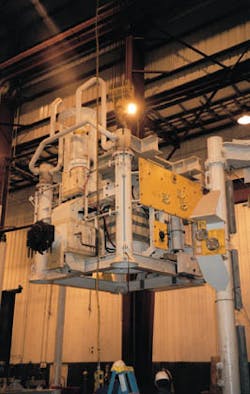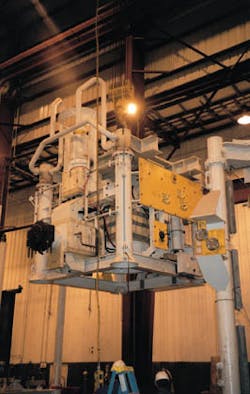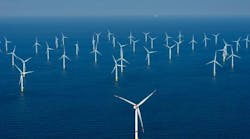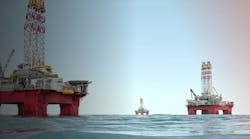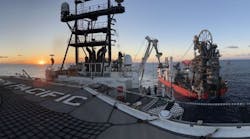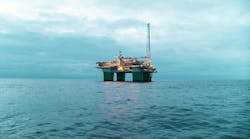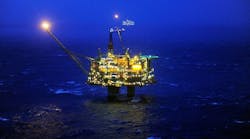Troika example of reservoir, completion challenges
Jerry Greenberg
Contributing Editor
One of Troika's trees is shown in a test installation on the completion guidebase at Cameron's facility. The BP subsea production facility will feature some of the highest flow rates in the US Gulf.As more wells are drilled in the deep waters of the Gulf of Mexico, the industry will likely see higher flow rates per well than those experienced in shallower waters because of generally better deepwater reservoirs that are conducive to higher flow rates.
The industry is preparing for this in several ways, including new innovations to handle production in deepwater and colder environments, and well testing equipment with the capacity to handle the anticipated higher flows, among other things.
With the high cost of drilling in the deep and ultra-deepwater of the Gulf of Mexico, it is to the operator's advantage to produce at the highest possible rate without damaging the formation or depleting the reservoir too quickly, in order to realize a quick return on the investment. High flow rate wells generally mean a quicker return on investment and can reduce costs because of fewer wells that may need to be drilled.
Several Gulf of Mexico deepwater operators compare the high flow rate wells in the North Sea and the US Gulf. "Reservoir pressures are higher in the US Gulf than in the North Sea," said Harold Bross, Team Leader, Production Assurance for Shell Deepwater Development, "but we have had a different philosophy in the Gulf than in the North Sea. North Sea wells are flowing at higher rates because they know they can flow at high rates. We have probably been limiting our sites on how well our wells can produce."
Most deepwater operators say the US Gulf can also experience high flow rate wells. For example, wells in the North Sea Heidrun field produce at a rate of 20,000-30,000 b/d per well.
The best well was reported to be producing around 46,000 b/d. In the Gulf of Mexico, the Troika field set the Gulf record for a producing well at 30,000 b/d.
This philosophy may be changing. "Our investment is so great in deepwater," Bross said, "that we want the highest rate possible for a quick return on that investment."
Surface constraints
"Surface equipment is a constraining factor," explains Derrick Booth with Subsea Data Services. "Is there a large enough production train and other surface equipment to handle high flow rates from several wells. The Gulf of Mexico industry may have to bring in North Sea type ideas and equipment, such as large capacity oil/water separators and other equipment.""A peculiar problem in the Gulf is that the infrastructure is mainly in shallow water," said Booth. "The only way to go from a deepwater well to the infrastructure is to connect to a shallower water pipeline through a host platform. Shell's Bullwinkle platform was somewhat of a disappointment, from its initial expectation, but it is being used effectively as a hub for several fields."
Shell earlier was in discussions with Marathon to tie back production from the Angus development in about 2,000 ft. of water in Green Canyon Block 113. The Angus field, about 12 miles from Bullwinkle, is estimated to produce at peak rates of 40,000 b/d.
Shell also was talking with Marathon to tie production from its Green Canyon Block 112 development back to Bullwinkle. But, in order to handle the increased production from the fields, production capacity on Bullwinkle was increased from 55,000 b/d to about 200,000 b/d. The Troika field alone, which is tied back to the Bullwinkle platform, is expected to take about half of that capacity.
Records, innovations
The first high flow rate wells in the deepwater Gulf of Mexico were discovered in the Troika field, equally owned by BP Exploration, Marathon, and Shell, with BP as the designated operator. The field is located in about 2,700 ft of water in the Green Canyon area which includes Blocks 200, 201, 244, and 245.Troika contains the Gulf of Mexico record holder for the well with the highest flow rate at about 30,000 b/d of oil. The field is expected to produce at peak rates of between 80,000-100,000 b/d. The life of the field is expected to be at least 15 years, with more than 200 million bbl of oil equivalent expected to be produced during that time. Production from the Troika subsea wells is tied to Shell's Bullwinkle platform 14 miles away in 1,350 ft of water.
At least two things are required to achieve high production rates:
- Good quality reservoir
- Proper completion technique.
"To achieve high flow rates, you have to get the completion right and monitor and manage drawdown. The second and third wells might not have been done exactly right. However, the fourth well is expected to flow at rates approaching 30,000 b/d. Wells five and six could produce at 30,000 bbl daily, but it's too early to determine that." Five wells were planned initially.
The primary reservoir of the field is about 16,000-18,000 ft below the seafloor. The field is being developed with horizontal wells. Initial bottomhole pressure in the primary reservoir is approximately 10,900 psi, with bottomhole temperatures ranging from 160-180° over the oil column.
Hydrates, paraffin
One of BP's concerns is the formation of hydrates and paraffin in the subsea production system because of the cold environment of the deep waters. Consequently, the entire production system, from the subsea trees to the manifold and the flowlines to the Bullwinkle plat form, is insulated to minimize heat loss during production. To reduce or eliminate paraffin, the well com pletions are designed so that wellbore temperature is maintained above the cloudpoint of 105° F.For insulation of sections of the production system that could be pre-molded, a syntactic material similar to riser buoyancy modules is used. For other areas, a syntactic composite of tiny hollow glass beads surrounded by epoxy resin was formulated to create sheets of insulation that were cut to fit components.
The subsea trees are conventional 10,000 psi, dual bore 4-in. by 2-in. configuration supplied by Cameron. One question regarding high flow rate wells such as the 30,000 b/d well in the Troika field is: Would a higher flow rate be obtained by utilizing a larger bore wellhead and larger tubing?
"It all depends on the reservoir," Bednar said. "Larger tubulars sometimes means larger flows, but only for a short time before the field is depleted."
Larger subsea trees
Subsea tree manufacturers can supply trees with an inside diameter of up to 6 3/8-in. today, to be utilized with 7-in. production tubing. Trees that size have not been utilized in the Gulf of Mexico to date, but several are being installed in the UK North Sea."We sent 10 conventional trees with a 6 3/8-in. bore to BP for its Schiehallion project in the North Sea last year," said Britt Schmidt, Product Manager, Subsea Trees & Wellhead for Cooper. The company also has a 6 3/8-in. design spool tree, but none have been shipped as yet.
There are trees as large as 9-in. inside diameter but these have only been utilized onshore, including wells in Indonesia, Peru, the Netherlands, and in the Middle East. "The 9-in. tree may be adaptable to subsea and offshore, but we haven't received any requests for them," said Jerry Skweres, Manager of Western Hemisphere Projects for Cooper. "These 9-in. trees are used in various onshore gas developments. But we have had no problems with high flow rates through 4-in. subsea trees."
"The entire completion string helps determine the flow rate," said Bross, of Shell Deepwater Development. "Ten to 15 years ago, a large completion in the Gulf of Mexico used 2 7/8-in. tubing. Now we're seeing completions with as high as a 4 1/2-in. tubing and we're looking at developments with larger designs. With 4-in. tubing, you can get 20,000 b/d or so per well but deepwater reserves could use a 5-in. bore tree, which I think would be the maximum necessary."
"Some reservoirs in the deepwater Gulf of Mexico can produce more than 20,000 b/d of oil per well," Bross continues. "Ram-Powell wells tested as high as 30,000 b/d. The completion technique has a lot to do with the flow rate, but generally deepwater Gulf of Mexico has thicker sands and higher permeability that is conducive to high flow rates."
Reliability
The number one concern is reliability of equipment for long-term use without intervention. "It's a long distance from the subsea well to the production facility," said Mike Tweedy with Chev ron. "The industry needs equipment that can last at least 10 years or more without problems, because of a tight deepwater rig market and the expense of removing and repairing equipment that has to be retrieved from deepwater."Subsea trees today are manufactured with high strength steels and alloys that mean longer life. The inside of trees manufactured by several different companies is clad with Alloy 625 to reduce corrosion and erosion. And while there may be some corrosion problem with carbon dioxide and hydrogen sulfide, which can be reduced with the use of chemicals injected into the flowlines, erosion is not a problem with oil by itself.
The problem of sand entering the wellbore is virtually eliminated with the proper completion, and although minute sand particles may squeeze past the sand screen, they generally are not a problem with regards to erosion.
Testing high flow rates
In anticipation of high flow rate wells, Halliburton Energy Services (HES) and Expro Americas have formed an alliance to provide subsea technology and testing services in the Gulf of Mexico. And as some in the industry have mentioned, the alliance is using some North Sea ideas and equipment to accommodate the potentially high flow rates in the Gulf.While the two companies have worked together on about three dozen projects in the Gulf during the past five years, the recent alliance formalizes the partnership. The alliance offers subsea intervention services and well testing.
Much of the equipment that will be used for drillstem testing of deepwater Gulf of Mexico wells has been brought in from the North Sea in anticipation of high flow rate wells. "Expro was chosen to be an alliance partner partly because of its North Sea experience," said Curtis Wilie, Technical Advisor with HES. "We felt it was important to bring someone in with North Sea experience."
"Surface separation equipment that we have used in the North Sea has been delivered to the Gulf of Mexico and is warehoused in Louisiana near Lafayette," said Mark Riddell, with Expro Americas in Houston. "The surface equipment is specifically targeted for deepwater and high flow rate tests, and can handle 24,000 b/d of oil and 90 MMcf/d of gas.
"The 24,000 b/d oil test capacity could be increased depending upon the amount of gas also produced. The less gas produced during the test, the higher the oil flow rate can be tested. We have also brought in high rate burner heads that can burn off up to 15,000 b/d of oil, but they can be configured to burn up to 20,000 b/d."
"Smaller capacity test equipment can sometimes mean having to install two sets of equipment in parallel to handle the flow, resulting in a much larger setup," Riddell said. "Depending on the type of rig on which it is to be installed, it physically may not fit. The virtue of having high rate equipment is that you need just one set-up."
"Also," Riddell adds, "The Minerals Man agement Service has to approve the drillstem test. If an operator wants to test at a high rate and doesn't have the equipment, it's not going to be approved. Our equipment can handle most high flow rate tests and provide more of a cushion during the test. And I anticipate there may be extended well tests in the Gulf in the future, rather than the normal one or two days."
When the companies complete a well, they sometimes install downhole metering technology that monitors the well pressure or indicates if there is a production rate drop in each well. It is up to the operator if downhole metering is desired. The metering allows monitoring of a particular well, rather than having to shut down production to test each well if a pressure drop or production rate decrease is detected at the manifold. Information is transferred electrically to the surface, but HES is testing prototypes of a fiber optic monitoring system as well as an acoustic telemetry monitoring system.
Wilie expects 15,000-20,000 b/d per well to become the standard flow rate for deepwater Gulf of Mexico fields. There is generally, he says, off the shelf surface equipment capable of handling wells flowing at up to 20,000-25,000 b/d. "But cost is a major concern in deepwater," said Wilie, " and the industry has zero tolerance for downtime."
Author
Jerry Greenberg is a freelance writer based in Houston, Texas. He has 18 years experience in the offshore industry. He can be reached via e-mail at [email protected]or fax at 281-568-0254.Copyright 1998 Oil & Gas Journal. All Rights Reserved.
